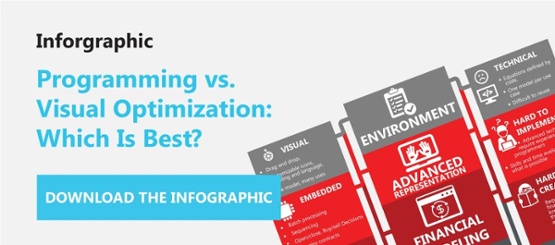Great question, as optimization has to date mainly been applied in silo functions – whether to optimize the choice of routes, a set of marketing campaigns or perhaps production. Considering what optimization does – help users make the best decisions considering a set of constraints or trade-offs – then the value is always greater with a larger problem as the impact of the optimization would be larger. Looking at the problem from a business angle, it’s where the user can optimize the enterprise – optimizing supply and demand simultaneously.
Optimizing Supply and Demand Simulateneously with IBP
At River Logic we call this Integrated Business Planning (IBP) – the ability of the business to make decisions about which demand to pursue, with what products/services and with the right resource configuration while considering all relevant market, regulatory, physical and policy constraints. All supported by one model.
There are multiple examples of this:
- Hospitals can optimize the services they deliver (and their physician line ups) simultaneously with the back-end resources and cost of delivering the services, considering how they get paid (and how much) – if the objective is profit, focus on the right physicians and services; if the objective is cost/ throughout/quality, optimize how the services are delivered and which demand is met where
- CPG companies prioritize product mix and marketing campaigns while optimizing their sourcing and capacity planning decisions – no longer promoting the products that contribute marginally to the business but rather focusing on those that truly move the needle
- Mortgage services organizations can define what kinds of mortgages and MSRs to pursue while aligning their back end processes and costs accordingly, considering their scarce capital availability and the capabilities of its staff; furthermore, optimize decisions on buying selling mortgages and MSRs considering a holistic impact on the business
- See the blog on coal mining for a deeper dive into this topic - http://www.riverlogic.com/2014/02/integrated-business-planning-coal-mining/
Enterprise Optimization versus Sequential Approaches
The power of a single model for enterprise optimization can be contrasted to the sequential approaches to planning that are most prevalent in the market today. Consider the typical framework for Sales & Operations Planning (S&OP). S&OP dictates that the planners should first lock down the sales forecast (demand plan), then create the supply plan, go back to the demand plan if something is not feasible and finally translate all this into a financial plan. Since it is done sequentially, there is no opportunity for globally optimizing the plan, instead limiting the power of planning to local optima. Many important questions are either completely unanswered or supported by misleading heuristics:
- When developing a sales/marketing plan, how to know which are the most profitable products or services? Note that historical unit costs are typically a poor indicator of future costs as these are influenced by volume, mix, input costs, etc. Furthermore, average costs almost always differ from marginal costs – the true unit of measure in making these types of decisions. Without considering supply, it’s impossible to truly answer these questions and people typically rely on heuristics
- As the supply plan is built, how to prioritize trade-offs? What is the best use of limited resources? Since the supply plan treats the demand plan as a fixed input, it’s impossible to consider or optimize decisions that would impact the product mix and/or revenue
- What should be our P&L and financial/KPI targets? When financials are translated sequentially, it’s impossible to really know these as the financials and KPIs are “totaled” out of the other plans – vs. being optimized. Therefore, managers typically shoot for targets that are achievable but might not push the organization to deliver “the best”
Take Your Organization to the Next Level
Optimization adds value anytime there are trade-offs and multiple choices – even a problem with 10 variables can benefit from it. Nevertheless, as the problem expands the value from optimization increases multiple-fold. IBP is not for the weak-kneed but definitely worth pursuing for visionaries who want to take their organizations to the next level in performance.







